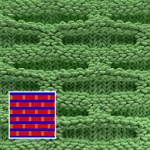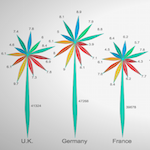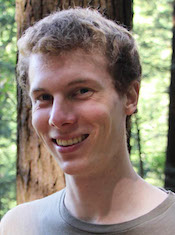About Me
I am a computer science Ph.D. candidate currently studying with
Steve Marschner in the
Graphics and Vision Lab at Cornell University.
My research interests include physically based animation and sound synthesis.
I started at Cornell in August of 2013. Before that, I graduated from Oberlin
College, where I received a B.A. with high honors in computer science and
minored in mathematics. For full details on my background, please see my C.V.
Research Publications

Interactive Design of Periodic Yarn-Level Cloth Patterns
Jonathan Leaf, Rundong Wu, Eston Schweickart, Doug L. James, and Steve Marschner.
ACM Transactions on Graphics (SIGGRAPH Asia 2018). 37(6), Article 202. November 2018.
We describe an interactive design tool for authoring, simulating, and adjusting yarn-level patterns for knitted and woven cloth. To achieve interactive performance for notoriously slow yarn-level simulations, we propose two acceleration schemes: (a) yarn-level periodic boundary conditions that enable the restricted simulation of only small periodic patches, thereby exploiting the spatial repetition of many cloth patterns in cardinal directions, and (b) a highly parallel GPU solver for efficient yarn-level simulation of the small patch. Our system supports interactive pattern editing and simulation, and runtime modification of parameters. To adjust the amount of material used (yarn take-up) we support "on the fly" modification of (a) local yarn rest-length adjustments for pattern specific edits, e.g., to tighten slip stitches, and (b) global yarn length by way of a novel yarn-radius similarity transformation. We demonstrate the tool's ability to support interactive modeling, by novice users, of a wide variety of yarn-level knit and woven patterns. Finally, to validate our approach, we compare dozens of generated patterns against reference images of actual woven or knitted cloth samples, and we release this corpus of digital patterns and simulated models as a public dataset to support future comparisons.

Animating Elastic Rods with Sound
Eston Schweickart, Doug L. James, and Steve Marschner.
ACM Transactions on Graphics (SIGGRAPH 2017). 36(4), Article 115. July 2017.
Sound generation methods, such as linear modal synthesis, can sonify a wide range of physics-based animation of solid objects, resolving vibrations and sound radiation from various structures. However, elastic rods are an important computer animation primitive for which prior sound synthesis methods, such as modal synthesis, are ill-suited for several reasons: large displacements, nonlinear vibrations, dispersion effects, and the geometrically singular nature of rods.
In this paper, we present physically based methods for simultaneous generation of animation and sound for deformable rods. We draw on Kirchhoff theory to simplify the representation of rod dynamics and introduce a generalized dipole model to calculate the spatially varying acoustic radiation. In doing so, we drastically decrease the amount of precomputation required (in some cases eliminating it completely), while being able to resolve sound radiation for arbitrary body deformations encountered in computer animation. We present several examples, including challenging scenes involving thousands of highly coupled frictional contacts.

Data-Driven Guides: Supporting Expressive Design for Information Graphics
Nam Wook Kim, Eston Schweickart, Zhicheng Liu, Mira Dontcheva, Wilmot Li, Jovan Popovic, and Hanspeter Pfister.
IEEE Transactions on Visualization and Computer Graphics (InfoVis 2016). 23(1). January 2017.
In recent years, there is a growing need for communicating complex data in an accessible graphical form. Existing visualization creation tools support automatic visual encoding, but lack flexibility for creating custom design; on the other hand, freeform illustration tools require manual visual encoding, making the design process time-consuming and error-prone. In this paper, we present Data-Driven Guides (DDG), a technique for designing expressive information graphics in a graphic design environment. Instead of being confined by predefined templates or marks, designers can generate guides from data and use the guides to draw, place and measure custom shapes. We provide guides to encode data using three fundamental visual encoding channels: length, area, and position. Users can combine more than one guide to construct complex visual structures and map these structures to data. When underlying data is changed, we use a deformation technique to transform custom shapes using the guides as the backbone of the shapes. Our evaluation shows that data-driven guides allow users to create expressive and more accurate custom data-driven graphics.
Other Research Experiences
Research Internship at Adobe Research
June-September 2018
Mentor: Tim Langlois
In the summer of 2018, I was an intern at
Adobe Research in Seattle, Washington. With my mentor, Tim Langlois, and my advisor, Steve Marschner, I explored using physically based elastic rod models to simulate yarn at a high level of detail.
(More details coming soon...)
June-September 2015
Mentors: Danny Kaufman and Jovan Popovic
In the summer of 2015, I was an intern at
Adobe Research in Seattle, Washington. I worked with Danny Kaufman and Jovan Popovic to develop a framework that took as input static 2D vector artwork of a character, along with motion data for various parts of a character (e.g., the head, torso, legs, and feet). After a few seconds of user input and precomputation, the framework would produce an animation of the character which matched the input motion data. The method was able to process many categories of character artwork, composed of anywhere from one to hundreds of SVG shapes.
June-August 2013
Mentor: Patrick Walton
I worked as a Research Intern
at Mozilla in the summer of 2013, developing an implementation of scalable tiled graphics using layered quadtrees. This
work was integrated into
Servo, an experimental web browser engine. Servo is written in Rust,
a safe, concurrent, and fast programming language also under development at Mozilla. At the end of the summer, I gave
a talk
about my work.
August 2012-May 2013
Mentor: Bob Geitz
I pursued a year long research project as part
of the honors program at Oberlin College. I constructed a program that displayed water
and electricity usage in Oberlin dormitories over time using interactive graphs created
using 3D modeling software. Users were able to compare this data with daily weather
conditions using 3D-model texturing. I then conducted a user study to determine what
effect, if any, using relevant texturing patterns had on the speed at which users could
interpret and process the data, as compared to a color key. I discovered that relevant
icons within the graph generally had a positive effect on the rate at which information
was gained. I wrote a
final report
summarizing my findings, and gave a presentation to the computer science department.
June-July 2012
Mentor: Aidong Lu
In the summer of 2012, I took part in the
Research Experiences for Undergraduates program at The University of North Carolina at
Charlotte, where I worked with Dr. Aidong Lu in the Visualization Department. I
created a portable tool for visualizing dynamic networks that elucidated both major and
subtle patterns within the data. Constructed using the javascript-based
visualization library
D3, the program imported data sets
containing networks (optionally with temporal data attached) and displayed them using
several different visualization techniques. Using D3 meant that the program was not tied
to a specific application, and I implemented various displays of the data to work with
diverse datasets. I made and presented a poster at the concluding undergraduate research
symposium, and I delivered a presentation to the program supervisors and participants.
June-August 2011
Mentor: Kyle Furge
I was Frederick and Lena Meijer
Student Intern at the
Van Andel Research Institute (VARI) under scientific investigator
Kyle Furge in the summer of 2011. VARI, located in Grand Rapids, MI, focuses on the
discovery of treatments for several types of cancer. I built a computational model of
growing and mutating cancer cells with which I was able to show a detectable difference
between genetic and epigenetic drug-defense mechanisms used by
cancer cells. I also developed a method for determining which mechanism is causing drug
resistance in vitro. The program was constructed using NetLogo,
which represented the model through an interactive visual interface from which I
conducted experiments. I presented my work to the VARI faculty at the end of the program.
Professional/Academic Activities
Teaching
I have worked as a T.A. nearly every semester since coming to Cornell. My duties have included giving lectures, holding discussion sections, designing homework and exam questions, holding office hours, and grading.
Service
I was a reviewer for IEEE VR 2018 and SIGGRAPH Asia 2018.
I regularly volunteer for the annual Expanding your Horizons event, which is a S.T.E.M. conference for 7-9th grade girls hosted by Cornell. I am usually involved with organizing a workshop in which we introduce students to basic computer science concepts using the Scratch programming environment.
I assist with the weekly C.S. Brown Bag Seminar, which involves inviting and introducing speakers within the field of Computer Science at Cornell. I was also the secretary for the Computer Science Graduate Organization from 2014 to 2017.
Etc.
Since I am originally from Colorado, I am obliged to acknowledge my love of hiking and skiing. I occasionally compose electronic music, peck around on guitar, and play steel drums.



